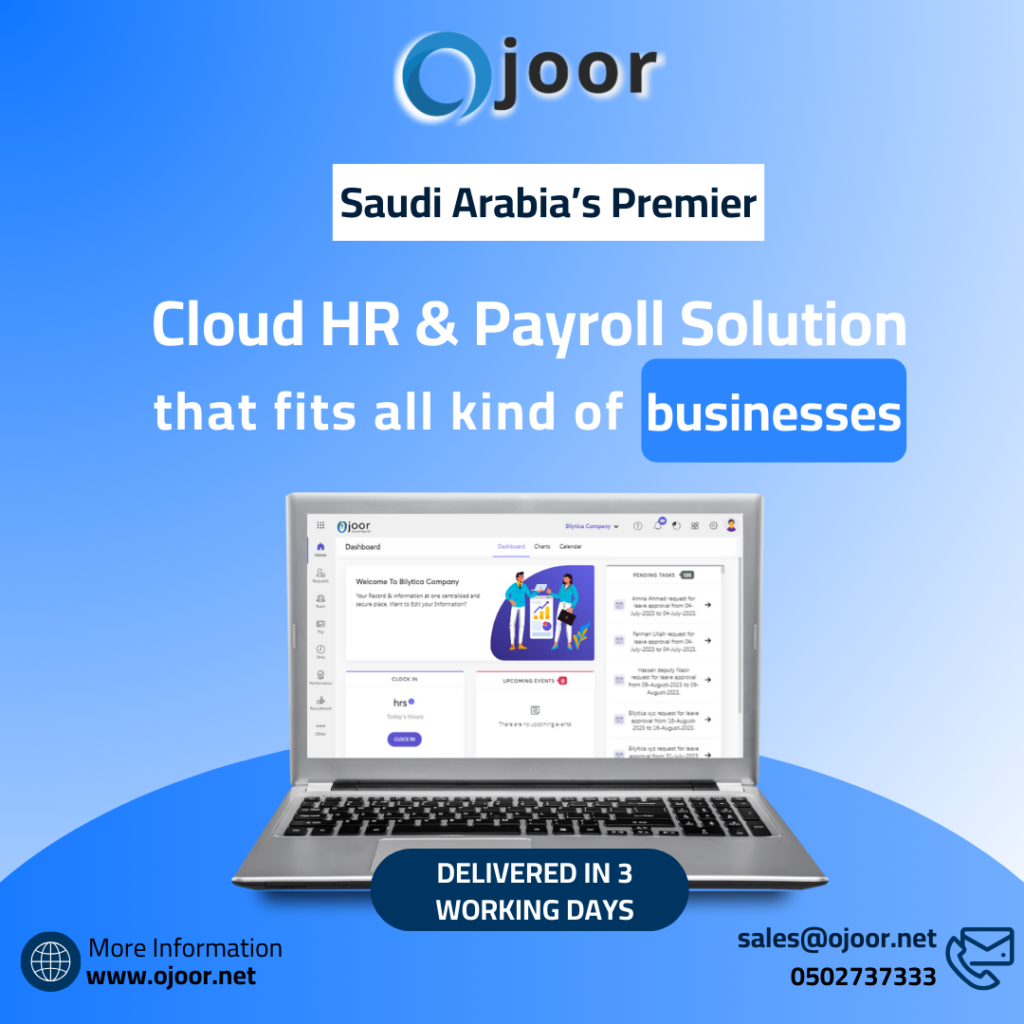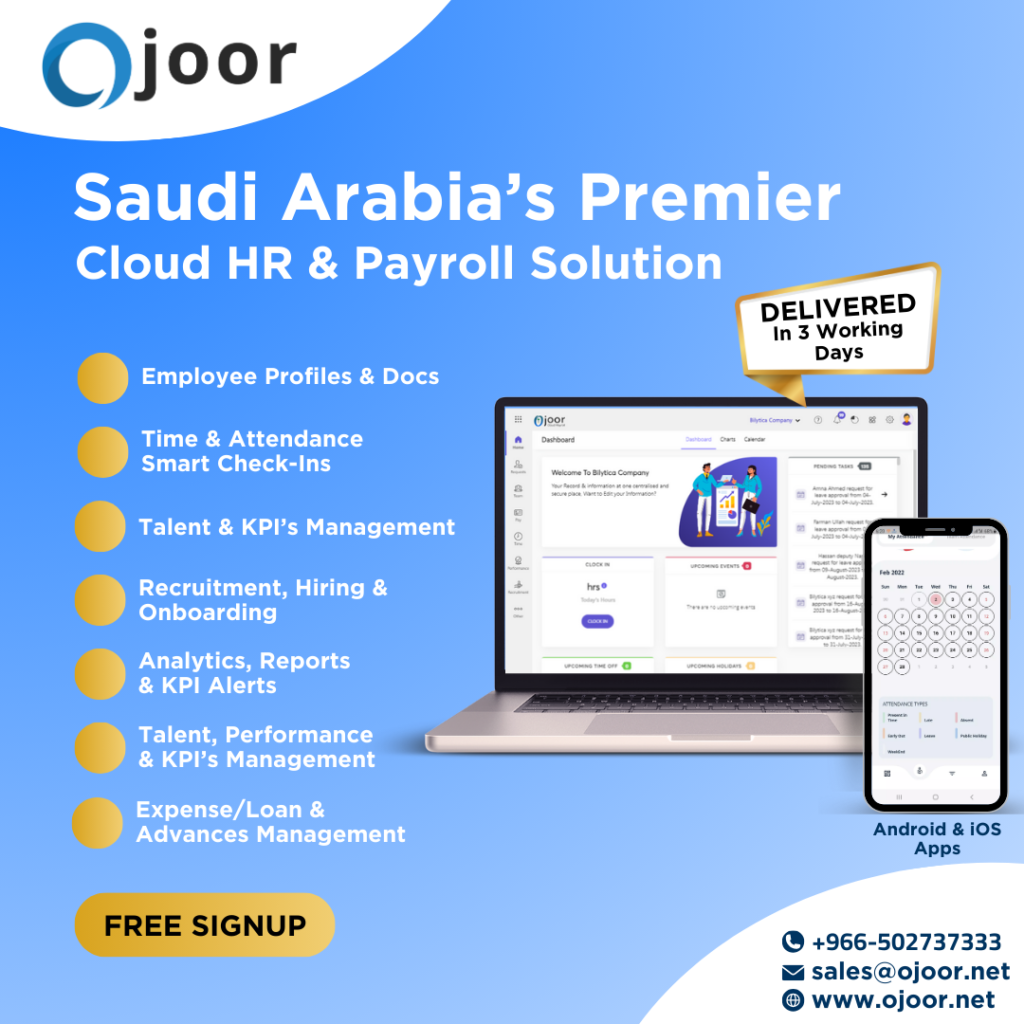Ojoor # 1 is one of the top Employee management software in Saudi Arabia and is an essential tool for organizations in Saudi Arabia, offering a range of features that streamline HR processes, enhance employee engagement, and ensure compliance with local regulations. As Saudi Arabian companies continue to grow and evolve, having robust EMS solutions is crucial for managing their workforce effectively. This article explores the key features of employee management software commonly used in Saudi Arabian organizations, highlighting how these features support efficient HR operations and contribute to overall business success.
Click to Start Whatsapp Chatbot with Sales
Mobile: +966547315697
Email: sales@Ojoor.net
Ojoor #1 Employee management software in Saudi Arabia
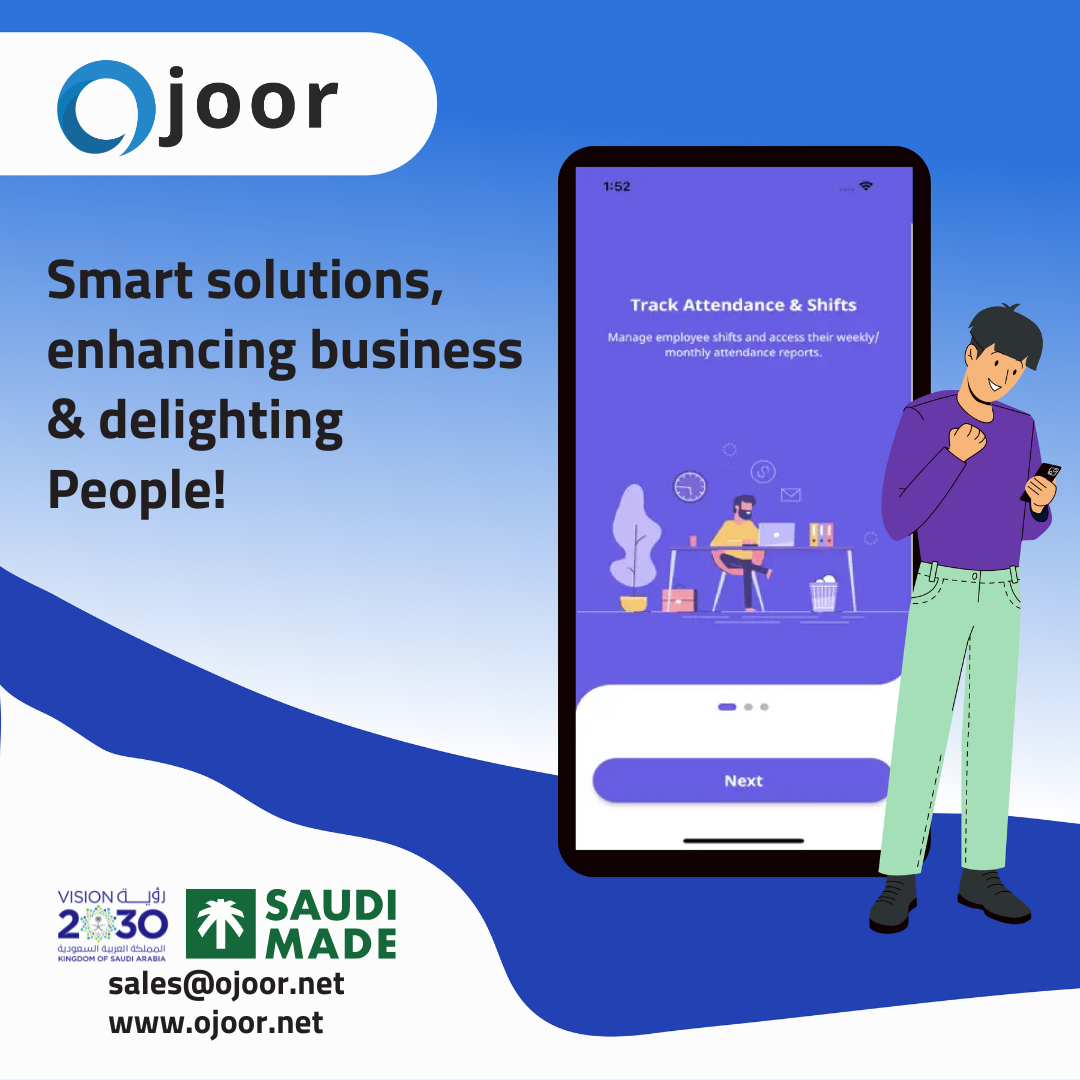
Centralized Employee Database
A centralized employee database is one of the core features of Employee management software in Saudi Arabia. It provides a unified platform for storing and accessing all employee-related information, including personal details, employment history, and performance records. Key aspects of this feature include:
- Unified Records: All employee data, including contact information, job titles, and work history, is stored in a single, easily accessible location. This centralization reduces the risk of data fragmentation and ensures that HR teams have up-to-date information at their fingertips.
- Search and Retrieval: Advanced search functionalities allow HR personnel to quickly retrieve specific employee records. This feature is particularly useful for managing large workforces and responding to information requests efficiently.
- Data Security: The centralized database is protected by robust security measures, including encryption and access controls, to ensure that sensitive employee information is safeguarded against unauthorized access.
In Saudi Arabia, where regulatory compliance and data protection are critical, having a centralized employee database helps organizations maintain accurate records and adhere to legal requirements.
Automated Payroll Management
Automated payroll management is a significant feature of EMS, streamlining the process of calculating and distributing employee salaries. Key components of this feature include:
- Salary Calculations: EMS systems automate the calculation of employee salaries, taking into account factors such as base pay, allowances, overtime, and deductions. This reduces the risk of errors and ensures accurate and timely payments.
- Tax and Compliance: Payroll systems are designed to handle tax calculations and comply with local labor laws, including Saudi Arabian regulations. This includes calculating social security contributions, withholding taxes, and generating required reports for regulatory authorities.
- Direct Deposit: Many EMS solutions offer direct deposit functionality, allowing employees to receive their salaries directly into their bank accounts. This feature enhances convenience and ensures timely payments.
In Saudi Arabia, where compliance with payroll regulations is essential, automated payroll management simplifies the process and helps organizations adhere to legal requirements.
Leave and Attendance Management
Leave and attendance management is a critical feature of EMS, enabling organizations to track employee attendance, manage leave requests, and ensure accurate record-keeping. Key aspects include:
- Attendance Tracking: EMS systems provide tools for tracking employee attendance, including clock-in and clock-out times. This feature helps organizations monitor attendance patterns and address issues such as absenteeism or tardiness.
- Leave Requests: Employees can submit leave requests through the EMS platform, which are then reviewed and approved by managers. The system maintains a record of all leave requests and approvals, making it easy to manage and track employee absences.
- Leave Balances: EMS systems automatically update leave balances based on the leave taken by employees. This feature provides both employees and HR teams with real-time information about available leave days and helps ensure that leave policies are followed.
In Saudi Arabian organizations, efficient leave and attendance management contributes to maintaining productivity and ensuring compliance with local labor laws.
Performance Management
Performance management features in EMS help organizations evaluate and enhance employee performance through systematic processes. Key components include:
- Performance Appraisals: EMS systems support the performance appraisal process by providing tools for setting goals, conducting evaluations, and tracking progress. This feature enables organizations to assess employee performance objectively and provide constructive feedback.
- Goal Setting: Managers and employees can set and track individual and team goals within the EMS platform. This feature aligns employee objectives with organizational goals and helps drive performance improvement.
- 360-Degree Feedback: Some Employee management software in Saudi Arabia offer 360-degree feedback capabilities, allowing employees to receive feedback from peers, subordinates, and supervisors. This comprehensive approach provides valuable insights into performance and areas for development.
In Saudi Arabia, where performance management is crucial for employee development and organizational success, EMS features help organizations implement effective appraisal processes and drive performance improvements.
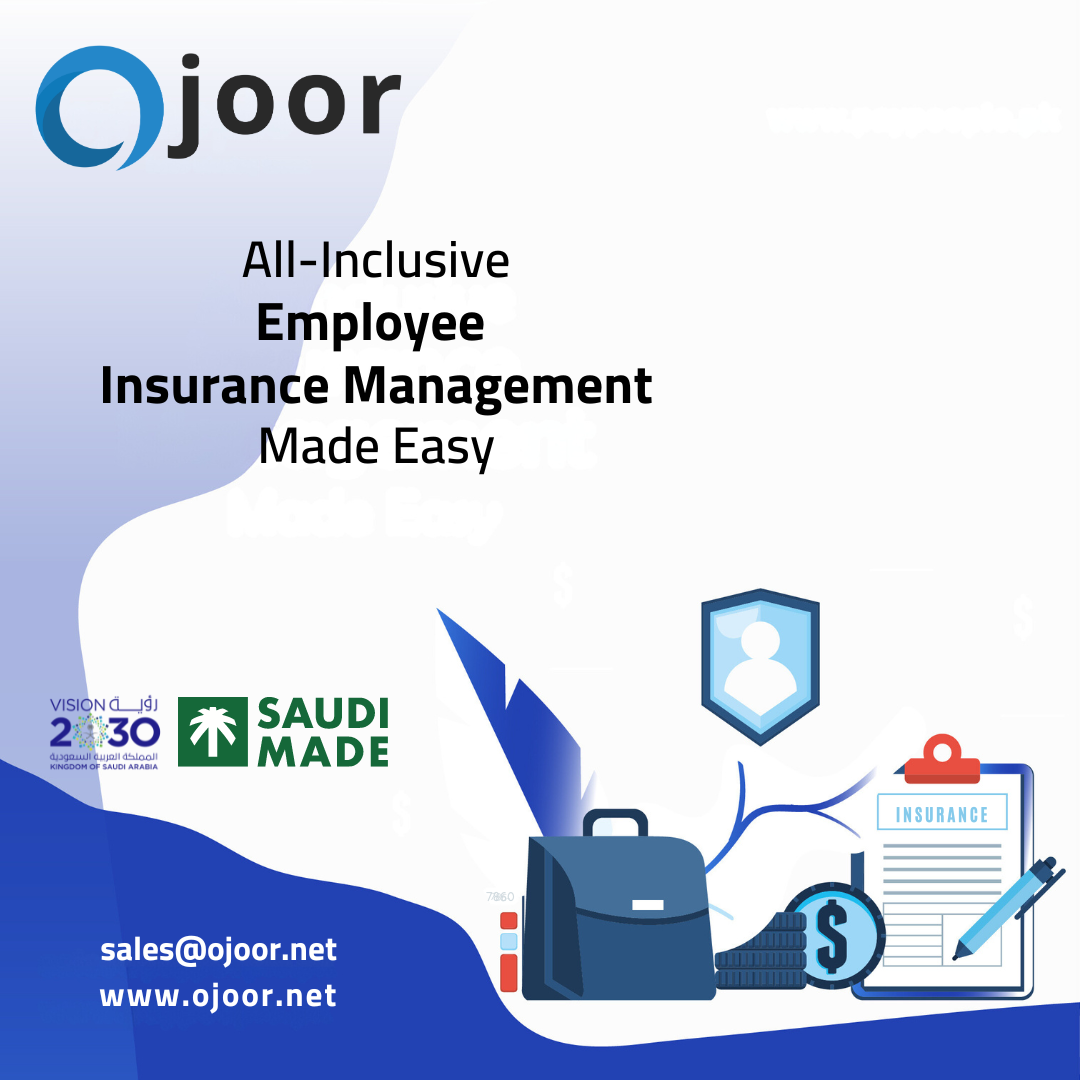
Recruitment and Onboarding
Recruitment and onboarding features in HR System in Saudi Arabia streamline the hiring process and help new employees integrate into the organization smoothly. Key aspects include:
- Applicant Tracking: EMS systems provide tools for managing the recruitment process, including tracking job applications, scheduling interviews, and communicating with candidates. This feature helps streamline hiring workflows and ensures that the best candidates are selected.
- Onboarding Checklists: The software includes onboarding checklists and workflows to guide new employees through the onboarding process. This feature ensures that all necessary steps, such as document submission and orientation, are completed efficiently.
- Integration with Job Boards: Many EMS solutions offer integration with job boards and recruitment platforms, allowing organizations to post job openings and manage applications from within the software.
In Saudi Arabia, where effective recruitment and onboarding are critical for attracting and retaining top talent, EMS features support organizations in managing these processes efficiently.
Employee Self-Service
Employee self-service features empower employees to manage their own HR-related tasks, reducing the administrative burden on HR teams. Key components include:
- Personal Information Management: Employees can update their personal information, such as contact details and bank account information, through the self-service portal. This feature ensures that employee records are kept up-to-date and accurate.
- Leave Requests: Employees can submit and track their leave requests through the self-service portal, allowing for greater transparency and convenience. This feature also enables employees to view their leave balances and history.
- Payslips and Tax Documents: Employees can access their payslips and tax documents through the self-service portal, providing them with easy access to important financial information.
In Saudi Arabian organizations, employee self-service features enhance convenience and efficiency, allowing HR teams to focus on strategic initiatives while employees manage routine tasks independently.
Compliance and Reporting
Compliance and reporting features in EMS help organizations adhere to local regulations and generate necessary reports for regulatory authorities. Key aspects include:
- Regulatory Compliance: EMS systems are designed to comply with local labor laws and regulations, including Saudi Arabian employment laws. This includes features for calculating statutory benefits, managing work permits, and adhering to labor regulations.
- Custom Reports: The software provides tools for generating custom reports on various HR metrics, such as employee turnover, attendance, and performance. These reports help HR teams analyze trends and make data-driven decisions.
- Audit Trails: EMS systems maintain audit trails of HR activities, providing a record of changes made to employee records and other data. This feature supports transparency and helps organizations address compliance issues.
For Saudi Arabian organizations, compliance and reporting features are essential for meeting legal requirements and ensuring that HR practices align with regulatory standards.
Integration with Other Systems
Integration with other systems is a key feature of EMS, allowing for seamless data flow and coordination between HR and other business functions. Key aspects include:
- ERP Integration: Many EMS solutions integrate with enterprise resource planning (ERP) systems, enabling data sharing between HR and finance departments. This integration supports processes such as payroll processing and financial reporting.
- HRIS Integration: Integration with human resource information systems (HRIS) ensures that employee data is synchronized across different HR applications. This feature helps maintain consistency and accuracy in employee records.
- Communication Tools: EMS systems often integrate with communication tools such as email and messaging platforms, facilitating communication between HR teams, managers, and employees.
In Saudi Arabia, where businesses rely on interconnected systems for efficient operations, EMS integration features enhance coordination and streamline HR processes.
Talent Management
Talent management features in EMS support organizations in identifying, developing, and retaining top talent. Key components include:
- Succession Planning: EMS systems help organizations plan for future talent needs by identifying potential successors for key roles and developing talent pipelines. This feature ensures that the organization is prepared for leadership transitions and other staffing changes.
- Learning and Development: Many Payroll System in Saudi Arabia solutions include features for managing employee training and development programs. This includes tracking training completion, managing certifications, and identifying skill gaps.
- Career Development: EMS systems support career development by providing tools for tracking employee career aspirations, setting development goals, and creating personalized career plans.
For Saudi Arabian organizations, talent management features help ensure that employees are developed and retained, contributing to long-term organizational success.
Conclusion
Employee management software is a powerful tool for Saudi Arabian organizations, offering a range of features that support efficient HR operations and contribute to overall business success. Key features include centralized employee databases, automated payroll management, leave and attendance tracking, performance management, recruitment and onboarding, employee self-service, compliance and reporting, integration with other systems, and talent management.
By leveraging these features, organizations in Saudi Arabia can streamline their HR processes, enhance employee engagement, and ensure compliance with local regulations. As the business landscape continues to evolve, adopting advanced EMS solutions will be crucial for managing the workforce effectively and driving organizational success.
Click to Start Whatsapp Chatbot with Sales
Mobile: +966547315697
Email: sales@Ojoor.net
Employee management Software in Saudi Arabia
Employee management Software in Saudi Arabia
Employee management Software in Saudi Arabia
Key features of Employee management software in Saudi Arabia similar software solutions prices were updated on 2025-12-19T23:21:06+00:00 in Saudi Arabia in Mecca, Medina, Riyadh, Khamis Mushait, Yanbu, Jeddah, Dammam, Unaizah, Uqair, Ha’il, Ta if, Al Bahah, Dhahran, King Abdullah Economic City, Najran, Diriyah, Qatif, Khafji, Jubail, Abqaiq, List of Cities and Towns in Saudi Arabia, Ras Tanura, Turubah, Jazan Economic City, Knowledge Economic City, Medina, Khobar, Abha, Tabuk, Saudi Arabia, similar software solutions prices were updated on 2025-12-19T23:21:06+00:00 We also provide in Saudi Arabia services solutions company in Hafar Al-Batin, Udhailiyah, Al-Awamiyah, Hofuf, Hautat Sudair, Buraidah, Tayma, Duba, ‘uyayna, Saihat, Al-Kharj, Al-ula, Jizan, Rumailah, Ar Rass, Arar, Shaybah, Al Majma’ah, Rabigh, Dhurma, Haradh, List of Saudi Cities by Gdp Per Capita, Badr, Sudair Industrial City, Baljurashi, Shaqraa, Al-Khutt, Habala, Ad Dawadimi, Dawadmi, Layla, similar software solutions prices were updated on 2025-12-19T23:21:06+00:00 Price is SAR 100 and this was updated on updated on 2025-12-19T23:21:06+00:00 similar Key features of Employee management software in Saudi Arabia software solutions prices were updated on 2025-12-19T23:21:06+00:00 in Saudi Arabia in Haql, Afif, Al-Abwa, Farasan, Al-Jaroudiya, Thadig, Al-Thuqbah, Al Wajh, Almardmah, Al-Zilfi, Muzahmiyya, Prince Abdul Aziz Bin Mousaed Economic City, Tharmada’a, Skaka, Um Al-Sahek, Sharurah, Tanomah, Bisha, Dahaban, Al Qunfudhah, Qurayyat, Saudi Arabia, Ha’ir, as Sulayyil, Al Lith, Turaif, Al-Gway’iyyah, Samtah, Wadi Ad-Dawasir, Az Zaimah, Safwa City, Jalajil, Harmah, Mastoorah, Hotat Bani Tamim, Jabal Umm Al Ru’us, Rafha, Qaisumah, Al-Ghat, Hajrah, Al-Hareeq. Excerpt: Jeddah (also spelled Jiddah, Jidda, or Jedda; Arabic: Jidda) is a Saudi Arabian city located on the coast of the Red Sea and is the major urban center of western Saudi Arabia similar software solutions prices were updated on 2025-12-19T23:21:06+00:00 Price is SAR 100 and this was updated on updated on 2025-12-19T23:21:06+00:00
21-8-2024
